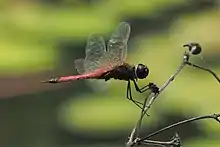Tramea transmarina
Tramea transmarina, known as the red glider or northern glider,[3] is a species of dragonfly in the Libellulidae family. The type locality for Tramea transmarina is Fiji, but subspecies are found in the islands of the Pacific, north-eastern Australia and Southeast Asia.[4][3]
| Tramea transmarina | |
|---|---|
 | |
| Male | |
| Scientific classification | |
| Domain: | Eukaryota |
| Kingdom: | Animalia |
| Phylum: | Arthropoda |
| Class: | Insecta |
| Order: | Odonata |
| Infraorder: | Anisoptera |
| Family: | Libellulidae |
| Genus: | Tramea |
| Species: | T. transmarina |
| Binomial name | |
| Tramea transmarina | |
 | |
| Synonyms | |
|
Tramea samoensis (Brauer, 1867) | |
Taxonomy
The following names are considered to be alternative names to Tramea transmarina Brauer, 1867:[4]
- Trapezostigma euryale Selys, 1878
- Tramea transmarina intersecta Lieftinck, 1975
- Tramea propinqua Lieftinck, 1942[lower-alpha 1]
- Tramea samoensis Brauer, 1867
Description
Tramea members typically have coloured bases to their hindwings. When they fly, this creates the impression of them carrying bags at the top of the abdomen; hence they are commonly known as saddlebags gliders. In general, adult males have a dark thorax and bright abdomen.
Wings
 Mating pair
Mating pair.jpg.webp) Female
Female.jpg.webp) Male
Male
References
- Wilson, K.D.P.; Rowe, R.; Marinov, M. (2020). "Tramea transmarina". IUCN Red List of Threatened Species. 2020: e.T167183A83375536. doi:10.2305/IUCN.UK.2020-1.RLTS.T167183A83375536.en. Retrieved 20 November 2021.
- Brauer, F. (1867). "Beschreibung neuer exotischer Libellen aus den Gattungen Neurothemis, Libellula, Diplax, Celithemis und Tramea". Verhandlungen der Zoologisch-Botanischen Gesellschaft in Wien. 17: 3–26 [21] – via Biodiversity Heritage Library.
- Theischinger, Günther & Hawking, John (2006). The complete field guide to dragonflies of Australia. CSIRO Publishing. ISBN 0-643-09073-8.
- Schorr, Martin; Lindeboom, Martin & Paulson, Dennis. "World Odonata List". University of Puget Sound. Retrieved 14 March 2015.
- Schorr, Martin; Paulson, Dennis. "World Odonata List". Slater Museum of Natural History. University of Puget Sound. Retrieved 24 February 2017.
- "Species Tramea propinqua Lieftinck, 1942". Australian Faunal Directory. Australian Biological Resources Study. 2012. Retrieved 20 February 2017.
